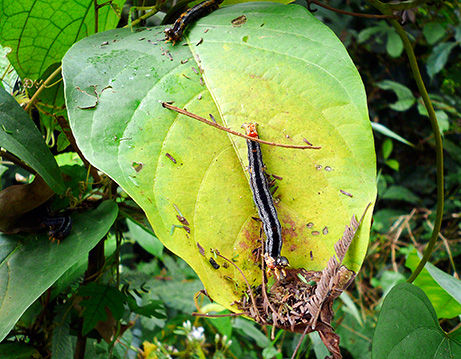Achaea catocaloides
Achaea catocaloides
Achaea catocaloides (also Acanthodelta catocaloides ) is a butterfly (moth ) from the family of cutworms ( Noctuidae ). He is regarded by his occasional outbreaks, especially in West Africa as a dangerous pest of crops. 2009, a proliferation rather than in Liberia and Ghana, which attracted considerable attention, although it was not the first great mass propagation of this kind in Liberia and West Africa.
Features
The moths have a wingspan of 45 to 50 mm and a length of 20 to 25 mm. The apex of the forewing is slightly tipped. The front upper wing surface is brown in color. Inner and outer transverse lines are drawn clearly dark brown. The inner transverse line is approximately straight curled up weakly, strongly serrated outer transverse line. In the position of the ring stigma, a small black spot is usually configured. The outer half of the middle field can also be darkened dark brown ( f nigra Berio ) or simply through the midfield diagonally a binding agent ( ex. virga Berio ). In the off. violacea, parts of the central panel be lightened. The kidneys blemish stands out from dark brown, however, is limited only vaguely to the midfield. The tops of the hind wings are in the base color also brown with different sized bright yellowish areas. The undersides are gray -brown. On the fore wings, the kidneys blemish stands out very clearly, also the Diskalfleck is developed. While the outer, but merely curved, not jagged transverse line is well developed, the inner transverse line is completely missing. On the hind wings a weak medial transverse line is present and a Diskalfleck. The wing brightens the inner edge and the wing attachment point indicates significantly.
The relatively slender caterpillar is ash-gray colored with a reddish brown head. It has a broad dark dorsal line and bright addition to ridge lines. The side lines are also very bright, the spiracles are black. At the rear end sit two bright red-colored bumps. The caterpillar is in the final stages 40 to 50 mm long.
Geographic occurrence and habitat
The species occurs in the tropical rain forests of West Africa. Shown is the way in Cameroon, Liberia, Nigeria, the Democratic Republic of Congo, Ivory Coast, Guinea, Benin, Kenya and Uganda. Presumably, the distribution area extends across more countries.
Way of life
The species is multivoltin, that is, it can be formed over new generations under favorable conditions throughout the year. The life cycle is only 36 to 45 days. The moths are about eight to twelve days old. Under farming conditions and if they are fed with sugar water, they can also survive up to 28 days. They are nocturnal and will suck fruits such as oranges and mangoes and fruit juice. The eggs are laid singly on the leaves of Dahoma tree ( Piptadeniastrum africanum ( Hook.f. ) Brenan ) in Liberia. For Nigeria Eluwa Pentaclethra macrophylla specifies as the main food crop. Eiraupen the hatch after about two to three days. The larval period lasts 20 to 22 days ( Eluwa are 15 to 16 days for Nigeria ). The relatively slender caterpillars move more like a spanner. In Liberia, the caterpillars first ate at the leaves of the trees Dahoma. The leaves are completely eaten up most of the middle and side fins. Are these defoliated, they drop to lower floors of the forest or abseil down strands. Then feed on various species of tropical trees, including crops such as coffee, cocoa, citrus species, plantains, bananas and cassava. The caterpillars pupate on the ground in the leaf litter under the trees befressenen in a cocoon of spider silk and woven together two leaves. The pupal period takes six to eight days.
Enemies
So far, only a few enemies of this type are known. In Cameroon, the populations are controlled mainly by ants. The Fly Blepharella lodosi Mesnil ( Tachinidae ) is called a parasite. For Nigeria Eluwa are generally on birds, lizards, wasps, ants, spiders and humans as enemies and specially a tachinid fly fly of the genus Exorista.
Harmful effect
The nature tends to occasionally outbreaks. At the beginning of 2009 provoked a proliferation in four counties in Liberia sensation (see also Liberian armyworm Plague (2009) ). The Government of Liberia has declared a state of emergency and asked for international aid. The living conditions of the population, particularly the mass invasions of the caterpillars have been affected in the villages into and through the contamination of water through the feces and dead caterpillars. The damage to the crop has been limited, since the crops were already introduced and the caterpillars do not eat grasses. Outbreaks have been documented previously from Liberia, but also from Cameroon and Benin.









